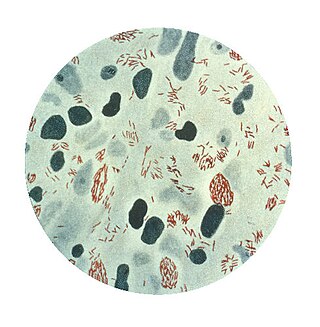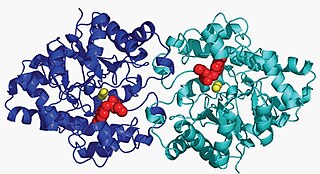
Escherichia coli ( ESH-ə-RIK-ee-ə KOH-ly) is a gram-negative, facultative anaerobic, rod-shaped, coliform bacterium of the genus Escherichia that is commonly found in the lower intestine of warm-blooded organisms. Most E. coli strains are harmless, but some serotypes such as EPEC, and ETEC are pathogenic and can cause serious food poisoning in their hosts, and are occasionally responsible for food contamination incidents that prompt product recalls. Most strains are part of the normal microbiota of the gut and are harmless or even beneficial to humans (although these strains tend to be less studied than the pathogenic ones). For example, some strains of E. coli benefit their hosts by producing vitamin K2 or by preventing the colonization of the intestine by pathogenic bacteria. These mutually beneficial relationships between E. coli and humans are a type of mutualistic biological relationship — where both the humans and the E. coli are benefitting each other. E. coli is expelled into the environment within fecal matter. The bacterium grows massively in fresh fecal matter under aerobic conditions for three days, but its numbers decline slowly afterwards.

Horizontal gene transfer (HGT) or lateral gene transfer (LGT) is the movement of genetic material between organisms other than by the ("vertical") transmission of DNA from parent to offspring (reproduction). HGT is an important factor in the evolution of many organisms. HGT is influencing scientific understanding of higher order evolution while more significantly shifting perspectives on bacterial evolution.

Mycobacterium leprae is one of the two species of bacteria that cause Hansen’s disease (leprosy), a chronic but curable infectious disease that damages the peripheral nerves and targets the skin, eyes, nose, and muscles.

Legionella pneumophila is a thin, aerobic, pleomorphic, flagellated, non-spore-forming, Gram-negative bacterium of the genus Legionella. L. pneumophila is the primary human pathogenic bacterium in this group and is the causative agent of Legionnaires' disease, also known as legionellosis.

Pentachlorophenol (PCP) is an organochlorine compound used as a pesticide and a disinfectant. First produced in the 1930s, it is marketed under many trade names. It can be found as pure PCP, or as the sodium salt of PCP, the latter of which dissolves easily in water. It can be biodegraded by some bacteria, including Sphingobium chlorophenolicum.

Sphingomonadaceae are a gram-negative bacterial family of the Alphaproteobacteria. An important feature is the presence of sphingolipids in the outer membrane of the cell wall. The cells are ovoid or rod-shaped. Others are also pleomorphic, i.e. the cells change the shape over time. Some species from Sphingomonadaceae family are dominant components of biofilms.

Nitrosomonas is a genus of Gram-negative bacteria, belonging to the Betaproteobacteria. It is one of the five genera of ammonia-oxidizing bacteria and, as an obligate chemolithoautotroph, uses ammonia as an energy source and carbon dioxide as a carbon source in presence of oxygen. Nitrosomonas are important in the global biogeochemical nitrogen cycle, since they increase the bioavailability of nitrogen to plants and in the denitrification, which is important for the release of nitrous oxide, a powerful greenhouse gas. This microbe is photophobic, and usually generate a biofilm matrix, or form clumps with other microbes, to avoid light. Nitrosomonas can be divided into six lineages: the first one includes the species Nitrosomonas europea, Nitrosomonas eutropha, Nitrosomonas halophila, and Nitrosomonas mobilis. The second lineage presents the species Nitrosomonas communis, N. sp. I and N. sp. II, meanwhile the third lineage includes only Nitrosomonas nitrosa. The fourth lineage includes the species Nitrosomonas ureae and Nitrosomonas oligotropha and the fifth and sixth lineages include the species Nitrosomonas marina, N. sp. III, Nitrosomonas estuarii and Nitrosomonas cryotolerans.
Organohalide respiration (OHR) (previously named halorespiration or dehalorespiration) is the use of halogenated compounds as terminal electron acceptors in anaerobic respiration. Organohalide respiration can play a part in microbial biodegradation. The most common substrates are chlorinated aliphatics (PCE, TCE, chloroform) and chlorinated phenols. Organohalide-respiring bacteria are highly diverse. This trait is found in some Campylobacterota, Thermodesulfobacteriota, Chloroflexota (green nonsulfur bacteria), low G+C gram positive Clostridia, and ultramicrobacteria.
Paenarthrobacter ureafaciens KI72, popularly known as nylon-eating bacteria, is a strain of Paenarthrobacter ureafaciens that can digest certain by-products of nylon 6 manufacture. It uses a set of enzymes to digest nylon, popularly known as nylonase.
Dehalococcoides is a genus of bacteria within class Dehalococcoidia that obtain energy via the oxidation of hydrogen and subsequent reductive dehalogenation of halogenated organic compounds in a mode of anaerobic respiration called organohalide respiration. They are well known for their great potential to remediate halogenated ethenes and aromatics. They are the only bacteria known to transform highly chlorinated dioxins, PCBs. In addition, they are the only known bacteria to transform tetrachloroethene to ethene.
Microbial biodegradation is the use of bioremediation and biotransformation methods to harness the naturally occurring ability of microbial xenobiotic metabolism to degrade, transform or accumulate environmental pollutants, including hydrocarbons, polychlorinated biphenyls (PCBs), polyaromatic hydrocarbons (PAHs), heterocyclic compounds, pharmaceutical substances, radionuclides and metals.

Aryldialkylphosphatase is a metalloenzyme that hydrolyzes the triester linkage found in organophosphate insecticides:

In the fields of molecular biology and genetics, a pan-genome is the entire set of genes from all strains within a clade. More generally, it is the union of all the genomes of a clade. The pan-genome can be broken down into a "core pangenome" that contains genes present in all individuals, a "shell pangenome" that contains genes present in two or more strains, and a "cloud pangenome" that contains genes only found in a single strain. Some authors also refer to the cloud genome as "accessory genome" containing 'dispensable' genes present in a subset of the strains and strain-specific genes. Note that the use of the term 'dispensable' has been questioned, at least in plant genomes, as accessory genes play "an important role in genome evolution and in the complex interplay between the genome and the environment". The field of study of pangenomes is called pangenomics.
Pentachlorophenol monooxygenase (EC 1.14.13.50, pentachlorophenol dechlorinase, pentachlorophenol dehalogenase, pentachlorophenol 4-monooxygenase, PCP hydroxylase, pentachlorophenol hydroxylase, PcpB, PCB 4-monooxygenase, PCB4MO) is an enzyme with systematic name pentachlorophenol,NADPH:oxygen oxidoreductase (hydroxylating, dechlorinating). This enzyme catalyses the following chemical reaction
Sphingomonas yanoikuyae is a short rod-shaped, strictly aerobic, Gram-negative, non-motile, non-spore-forming, chemoheterotrophic species of bacteria that is yellow or off-white in color. Its type strain is JCM 7371. It is notable for degrading a variety of aromatic compounds including biphenyl, naphthalene, phenanthrene, toluene, m-, and p-xylene. S. yanoikuyae was discovered by Brian Goodman on the southern coast of Papua New Guinea. However, Sphingomonas have a wide distribution across freshwater, seawater, and terrestrial habitats. This is due to the bacteria's ability to grow and survive under low-nutrient conditions as it can utilize a broad range of organic compounds.
Desulfitobacterium hafniense is a species of gram positive bacteria, its type strain is DCB-2T..
Dehalogenimonas lykanthroporepellens is an anaerobic, Gram-negative bacteria in the phylum Chloroflexota isolated from a Superfund site in Baton Rouge, Louisiana. It is useful in bioremediation for its ability to reductively dehalogenate chlorinated alkanes.
Symbiobacterium thermophilum is a symbiotic thermophile that depends on co-culture with a Bacillus strain for growth. It is Gram-negative and tryptophanase-positive, with type strain T(T). It is the type species of its genus. Symbiobacterium is related to the Gram-positive Bacillota and Actinomycetota, but belongs to a lineage that is distinct from both.S. thermophilum has a bacillus shaped cell structure with no flagella. This bacterium is located throughout the environment in soils and fertilizers.
Sphingobium japonicum is a hexachlorocyclohexane-degrading bacteria with type strain MTCC 6362T. Its genome has been sequenced.
Methylosinus trichosporium is an obligate aerobic and methane-oxidizing bacterium species from the genus of Methylosinus. Its native habitat is generally in the soil, but the bacteria has been isolated from fresh water sediments and groundwater as well. Because of this bacterium's ability to oxidize methane, M. trichosporium has been popular for identifying both the structure and function of enzymes involved with methane oxidation since it was first isolated in 1970 by Roger Whittenbury and colleagues. Since its discovery, M. trichosporium and its soluble monooxygenase enzyme have been studied in detail to see if the bacterium could help in bioremediation treatments.









